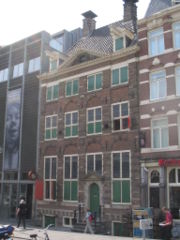
Jodenbreestraat
Encyclopedia

Amsterdam
Amsterdam is the largest city and the capital of the Netherlands. The current position of Amsterdam as capital city of the Kingdom of the Netherlands is governed by the constitution of August 24, 1815 and its successors. Amsterdam has a population of 783,364 within city limits, an urban population...
, The Netherlands. The street runs from the Sint Antoniesluis sluice gates to the Mr. Visserplein traffic circle. The street was home to the painter Rembrandt.
Rembrandt lived in this street from 1631 to 1635, at the home of art dealer Hendrick van Uylenburgh
Hendrick van Uylenburgh
Hendrick van Uylenburgh was an influential Dutch Golden Age art dealer who helped launch the careers of Rembrandt, Govert Flinck, Ferdinand Bol and other painters....
, and again from 1639 to 1656, in his own house, which was built in 1660 and still stands today. It now houses the Rembrandthuis museum. The street was also popular with other artists, such as the painter Esaias Boursse
Esaias Boursse
Esaias Boursse , was a Dutch painter. His paintings were mainly genre works.- Biography :He was born in Amsterdam, the youngest son of immigrants from Wallonia. His parents, Jacques Boursse and Anna des Forest, married in 1618 in Amsterdam...
, who lived next door to Rembrandt.
The street was originally part of the Sint Antoniesbreestraat
Sint Antoniesbreestraat
The Sint Antoniesbreestraat is a street in the centre of Amsterdam, The Netherlands. The street runs south from Nieuwmarkt square to the Sint Antoniesluis sluice gates....
. In the 17th century, many Jewish emigrants from Portugal
Portugal
Portugal , officially the Portuguese Republic is a country situated in southwestern Europe on the Iberian Peninsula. Portugal is the westernmost country of Europe, and is bordered by the Atlantic Ocean to the West and South and by Spain to the North and East. The Atlantic archipelagos of the...
and Spain
Spain
Spain , officially the Kingdom of Spain languages]] under the European Charter for Regional or Minority Languages. In each of these, Spain's official name is as follows:;;;;;;), is a country and member state of the European Union located in southwestern Europe on the Iberian Peninsula...
settled in the neighbourhood, and in the second half of the century, the southern section of the Sint Antoniesbreestraat came to be known as Jodenbreestraat ("Jewish Broad Street").
The street served as a marketplace until the late 19th century. In 1893, the city government ordered the merchants to move their stalls to nearby Waterlooplein
Waterlooplein
Waterlooplein is a square in the centre of Amsterdam, The Netherlands, near the Amstel river. The daily flea market on the square is popular with tourists. The Stopera city hall and opera building and the Mozes en Aäronkerk church are at Waterlooplein....
square.
During the German occupation of the Netherlands in World War II
World War II
World War II, or the Second World War , was a global conflict lasting from 1939 to 1945, involving most of the world's nations—including all of the great powers—eventually forming two opposing military alliances: the Allies and the Axis...
, many residents of the Jewish neighourhood were taken away to the concentration camps and killed. After the war, the neighbourhood was left deserted and many of the houses began to fall apart and were eventually torn down. In the 1960s, the city government unveiled plans to build a highway through the Jodenbreestraat, as well as a metro line underneath the street. To prepare for construction, Jodenbreestraat was significantly widened by tearing down the remaining houses along the north side of the street. However, following heavy riots in 1975, the highway plans were abandoned.
Along the empty north side of the street, a huge new building arose in 1971, stretching the entire length of the street: the Burgemeester Tellegenhuis. Popularly known as the "Maupoleum", it was repeatedly voted the ugliest building in Amsterdam, and was finally torn down in 1994 and replaced with two large buildings which house, among others, a theatre school and the municipal department of housing.
Across from the Rembrandthuis is a sculpture bearing a poem by Jacob Israël de Haan
Jacob Israël de Haan
Jacob Israël de Haan was a Dutch Jewish literary writer and journalist who was assassinated in Jerusalem by the Jewish paramilitary organization Haganah for his anti-Zionist political activities and contacts with Arab leaders. He is believed to be the first victim of Zionist political violence...
. The Mozes en Aäronkerk church stands at the southern end of the street. Directly behind the Jodenbreestraat is Waterlooplein
Waterlooplein
Waterlooplein is a square in the centre of Amsterdam, The Netherlands, near the Amstel river. The daily flea market on the square is popular with tourists. The Stopera city hall and opera building and the Mozes en Aäronkerk church are at Waterlooplein....
square with its daily flea market.

